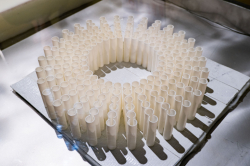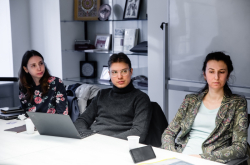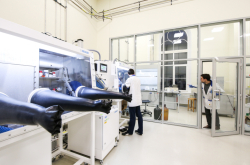Meet Mikhail:
Field of study: theoretical foundations of applied physics within the Quantum Nanophotonics and Optomechanics project at ITMO’s School of Physics and Engineering
Team: 25 people
Projects: Quantum Nanophotonics and Optomechanics, focusing on quantum memory that stores information in quantum computing. Mikhail Petrov’s team is also developing new approaches to managing nanostructures and designing converters, which are square transparent cards that make infrared beams visible. Such devices make it possible to adjust radiation without relying on special equipment, such as night-vision devices or special cameras.
Steps towards a career in science
My mother, father, and two uncles are physicists. Curiously, though, I wasn’t pushed into this field, it just happened. I was lucky enough to be surrounded by people who could explain the nature of everyday things, such as central heating or the gas system. The more explanations I received, the further my interest in physics grew.
In eighth grade, I transferred to a school focusing on physics and math in my hometown Tbilisi – and that was when my childhood ended, as I like to joke. Later, my family moved to St. Petersburg, as we had many relatives here, and I came to the Presidential Lyceum No. 239, one of the best schools in the city.
In 2003, when I graduated from school, a career in research was a questionable affair, but I wanted to continue exploring physics. I remember the moment that I told my father I was thinking of applying to Peter the Great St. Petersburg Polytechnic University. He nearly choked on his food and said, “Well, I think we can manage another physicist.” At the university, I studied solid matter physics and in my third year I started teaching and doing research. I continued my education with a Master’s degree from the same university and a double PhD degree from the St. Petersburg Academic University and the University of Eastern Finland.
Over all those years, I kept studying simply because I loved it. It’s like when you run every day just because you like it, not because you want to win the Olympics. I only asked myself where it was that I wanted to run at the end of my PhD studies. As a result, I decided to shift into more theoretical and fundamental studies. By this time, in 2014, ITMO’s Faculty of Physics had a whole band of researchers I’d known for years: Ivan Iorsh, Andrey Bogdanov, Anton Samusev, and Alexander Poddybny. After I’d met Irina Melchakova and Pavel Belov, I saw that working at ITMO would be fun, so I came to the university as a postdoc.
Soon, I was surrounded by students, while my research interests expanded. Two years ago, I realized that I already had a team of 20 people and it turned out that I was their PI.
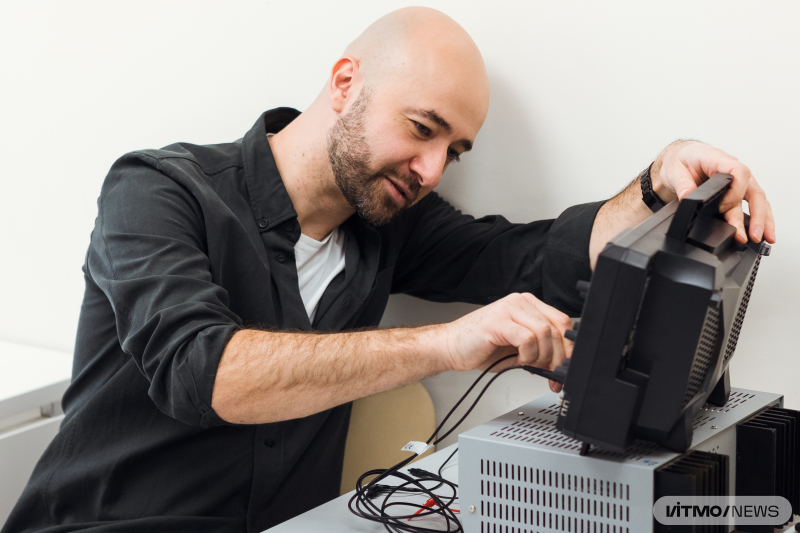
Mikhail Petrov with an oscillograph. Photo by Dmitry Grigoryev / ITMO.NEWS
The four horsemen: PI’s projects
Our main area of expertise is the theory behind applied physics, which allows us to speed up the development of new technologies. One of the projects with visible results is the development of effective converters for an infrared laser. These devices can make infrared radiation visible. Earlier, our team, in collaboration with scientists from Alferov University of the Russian Academy of Sciences and ETH Zurich, developed a transparent flexible membrane that not only makes an infrared beam visible but can also change its color to any other one in the rainbow. This device can be used in production or at optical labs when calibrating laser equipment.
We are primarily looking at the fundamentals of systems that work by generating higher optical harmonics. Currently, our objective is to produce one-micron-thin membranes for compact laser systems – so that the membrane is on the same scale as the laser’s wavelength. However, we can’t design a system at this scale using the existing theoretical framework, which means that we need to reinvent nonlinear optics at the subwave scale. If we succeed, we’d be able to create a laser with an on-a-chip membrane that can be used for non-invasive medical operations or in telecommunication systems to transmit and amplify the signal. In the future, our work can also contribute to the development of elements of photonic computers.
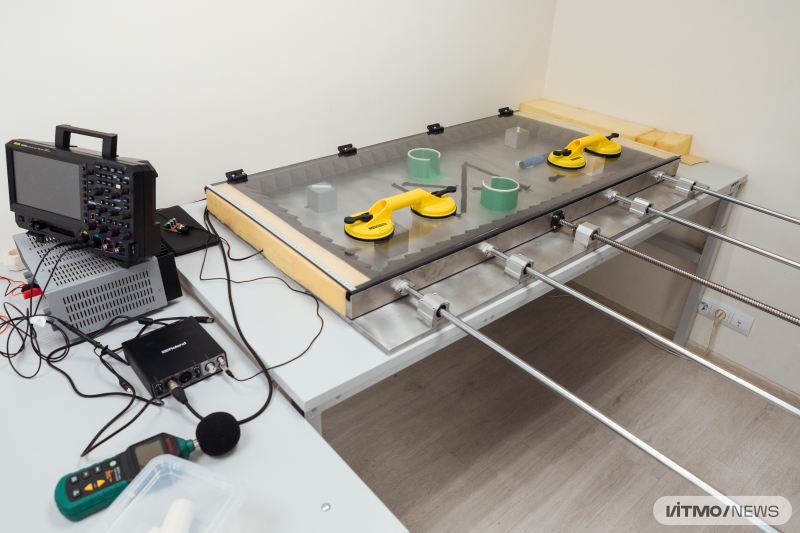
This device makes it possible to study the scattering of sound waves around objects to identify their properties. Photo by Dmitry Grigoryev / ITMO.NEWS
See also:
St. Petersburg Scientists Propose Prototype of New Infrared Visualizer
Our second field of research are quantum and optical systems, which are rightfully considered to be the future of quantum computing and simulation. Such systems are plenty and generally they follow the same principle: an optical signal reaches a quantum system; it implements a quantum protocol; and then the radiation exits the system. However, to paraphrase Leo Tolstoy, every quantum system is unhappy in its own way. Among all such systems, we are particularly interested in quantum memory – such devices can store quantum excitations without losing their properties. One of the solutions is using clouds of ultracold atoms that can maintain an optical signal and store it for a long time. In this work, we rely on our experience of working with nanophotonic resonators – small devices that can accumulate enough energy to amplify or generate laser radiation.
See also:
A Necklace of Resonators: How Scientists Efficiently Control Light in Nanoscale
Another focus area of the team are optical levitation and optical tweezers. This technology has been in the works since the 1960s and in 2018, American physicist Arthur Ashkin along with two other researchers was honored with the Nobel Prize for its development. Laser tweezers allow scientists to hold a microscopic particle (a molecule, nanoparticle, or cell) in the air, control it, and study its structure and properties. We are designing radically novel approaches to controlling micro objects by structuring the radiation and involving additional photonic structures.
See also:
Micro objects can also be controlled by acoustic levitation, whereby soundwaves hit the objects. We are developing supporting artificial metastructures with a specific geometry that will be able to hold and move several particles at once. We believe that this approach will be useful for sorting cells or nanoparticles.
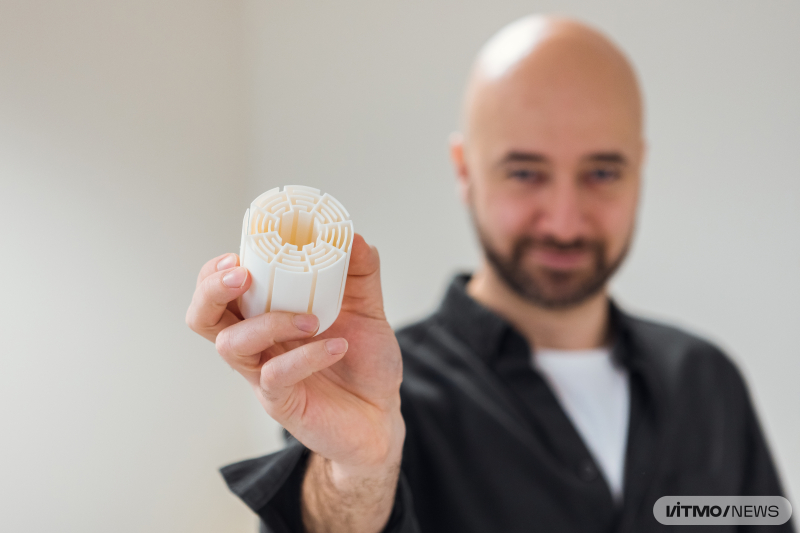
An acoustic metaatom – an artificial object with unique acoustic properties. Photo by Dmitry Grigoryev / ITMO.NEWS
See also:
A Quiet Place: ITMO Physicists Reduce Noise Tenfold With Metamaterial Structure
Managing teams and labs
Our research group of 25 people is working on all four projects. Mostly, our team includes theoreticians who don’t need special equipment, but recently we’ve started tapping into experimental physics as well. Our optics specialists work at the fully equipped labs on Lomonosova St. 9, while those responsible for acoustic levitation and metamaterials conduct their research on Birzhevaya Liniya 14-16.
As our team involves young researchers, as a PI I need to not only manage their work, but also serve as an HR specialist and even a psychologist. It’s important in order to know what motivates everyone on the team and how I can help them reach their goals.
Over the years, I’ve worked out the following team management principles:
- I prefer motivating my team instead of telling them what to do. This helps them follow their own gut and interest, without creating unnecessary pressure.
- It’s important to nourish openness and mutual support, avoiding competition within the team.
- Communication is key. Every week, we hold a group meeting to discuss ongoing work. Once every six months we sit down for a few hours with each member of the team, it’s a standard procedure at the faculty. At these meetings, we reflect on their work, discuss their successes, failures, preferences, and future plans.
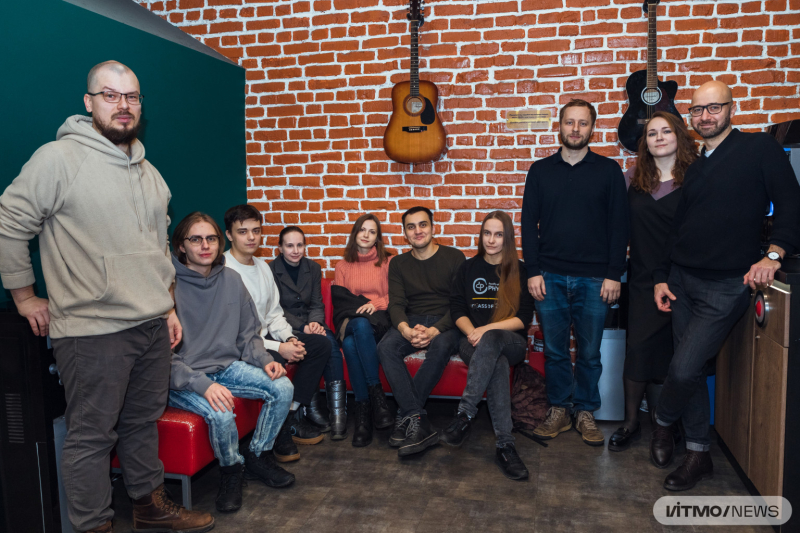
The team at the School of Physics and Engineering. Photo by Dmitry Grigoryev / ITMO.NEWS
Opportunities for PIs at ITMO
ITMO creates all the conditions for new PIs and scientific groups, including new spaces, equipment, and financial support within the federal program Priority 2030.
We also benefit a lot from the ITMO Fellowship program that allows us to attract researchers for specific projects and experiments. Recently, we were able to invite a highly qualified optician from Novosibirsk, who will be introducing machine learning to our project with optical tweezers.



